How to care for a blind dog likely weighs on your mind whether your dog has gone blind suddenly or gradually. It may sound daunting at first, but with these 30 tips from integrative veterinarian Dr. Julie Buzby, caring for and helping your blind dog will soon become second nature. And even better, they can help your blind dog regain his or her confidence and joy.
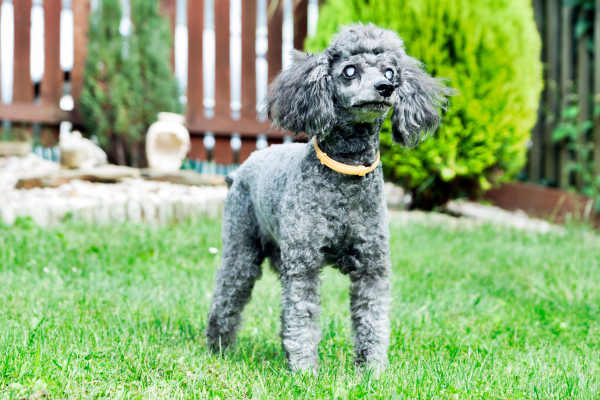
As humans, we rely heavily on our sight. So understandably, the idea of our beloved dog going blind can be distressing. You may immediately begin to wonder how your dog will cope with losing his or her sight and what you need to do to care for a blind dog.
There may even be a small voice in the back of your mind asking if it would be cruel to keep your blind dog alive. Before we go any further, please hear this and cling to it in the hard days. The vast majority of the time, blind dogs can go on to have an enjoyable full life.
Can blind dogs have a good life still?
The good news is that most dogs adjust well to being blind, in part because vision is their third most important sense (after hearing and smell). Plus, dogs tend to be resilient and adaptable. With a dedicated dog parent and some lifestyle changes, training sessions, and environmental modifications, a blind dog can continue to have a wonderful quality of life. And your bond with your dog may even grow stronger as you literally and figuratively walk through this with them.
However, you do need to know that occasionally there is a dog who doesn’t deal well with being blind. The transition tends to be harder for dogs who are already fearful or are dealing with other challenges like canine cognitive dysfunction or hearing loss in dogs. This doesn’t mean you shouldn’t try to help them adjust, just that occasionally it doesn’t work despite your best efforts.
How can you tell if your dog is going blind?
If your dog goes blind rapidly, it is often easier to notice the signs. However, dogs who lose their sight gradually learn to compensate, so it may not be obvious that they can’t see well until you take them into a new environment or they become completely blind.
Some signs your dog is going blind include:
- Bumping into objects
- Standing in one place as if frozen
- Getting stuck in the corner of the room or behind furniture
- Tripping over objects or seeming clumsy
- Walking very slowly or hesitantly
- Being reluctant to go up or down the stairs or jump onto the furniture
- Having trouble finding food, water, toys, or treats
- Running into the edge of the doorways or missing the step to go outside
- Acting nervous, scared, or aggressive
- Being easily startled
- Changes to the appearance of the eyes (cloudy eyes in dogs, redness, swelling, discharge, enlarged pupils, etc.)
- Having trouble navigating new surroundings
Caring for a blind dog starts by partnering with your vet
If you notice your dog seems to be losing their vision, the best thing you can do is contact your vet. This is especially important if your dog’s eyes look red, cloudy, or swollen, or if your dog is squinting, pawing at the eyes, or holding the eyes closed. Some conditions like glaucoma in dogs (increased pressure in the eye) cause blindness. Plus, they can be very painful and require immediate treatment.
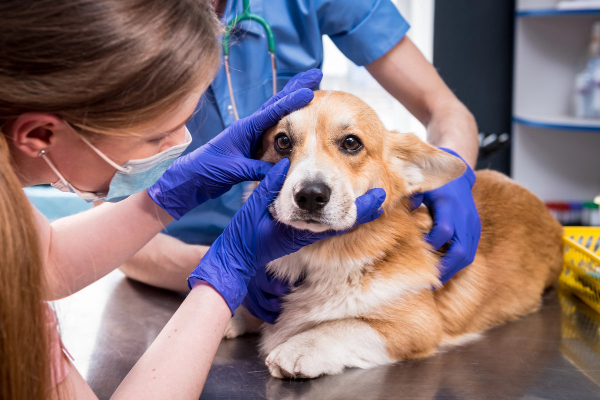
Additionally, if at any point in the future, you notice changes in your dog’s eyes, it is also important to make a vet appointment. Sometimes conditions that cause loss of vision may not initially be painful or require treatment. But they may end up causing problems for your dog down the road.
For example, cataracts in dogs (opacity of the lens) usually aren’t painful when the dog first goes blind. But as the cataracts progress, the dog can develop lens-induced uveitis in dogs and/or glaucoma, both of which are quite painful.
Your vet, or a veterinary ophthalmologist, can help determine if and why your dog is blind. Plus, they can advise you about what sort of treatments and monitoring (if any) might be needed to help manage your dog’s condition.
Helping a dog adjust to being blind
When your dog first becomes blind, it is going to take some time to rebuild his or her confidence and help him or her adjust to not being able to see. Some of the following seven tips can be useful for that time period (and beyond).
1. Create a safe area for your dog
While the goal is for your dog to eventually be able to safely navigate the whole house with ease, starting off with one small area can be comforting for some dogs. You may want to set up one room with your dog’s bed, food, water, and toys and not a lot of other furniture. This gives him or her a place to relax and feel comfortable before moving on to the rest of the house. If your dog likes his or her crate, you can include it in the safe area.
(Note: If your dog likes to relax in the crate, ensure you tie the door open when you want your dog to be able to go in and out freely. Otherwise, it may shut if your blind dog accidentally bumps into it.)
2. Be patient if your dog is initially withdrawn, fearful, or aggressive
Blindness takes some adjusting to, so your dog may not be himself or herself for a bit. It is normal for some dogs to want to hide or to not be interested in leaving their safe room at first. Sometimes a dog may also display some fear aggression.
Continue to be calm and patient as your dog adjusts, and try to take things at his or her pace. It might be a while before your dog wants to leave the yard and that is ok. Or your dog may not feel comfortable climbing the stairs for a few months, so he or she may stay on one floor. This is ok too.
Most of the time, your dog will get there eventually. In the meantime, focus on spending time with your dog and helping him or her adjust.
3. Crate your dog or put him or her in the safe area when you aren’t around to supervise
During the adjustment period, your dog may require some supervision and assistance to stay safe and navigate the house. If you are going to be gone or you are unable to be watching your dog for a period of time, it can be a good idea to put him or her in the safe room or crate (if your dog likes the crate).
If your dog normally roams the house at night, you may wish to put him or her in the crate or safe room then too. However, if your dog sleeps in your bedroom with you, closing the door to the bedroom might be sufficient.
4. Use baby gates to keep your dog safe
At first, you may want to put a baby gate at the top and bottom of the stairs or the entrance of any room you don’t want your blind dog going into. This can keep him or her from accidentally falling down the stairs or getting into other dangerous situations. As your dog learns his or her way around, you may be able to remove the gates.
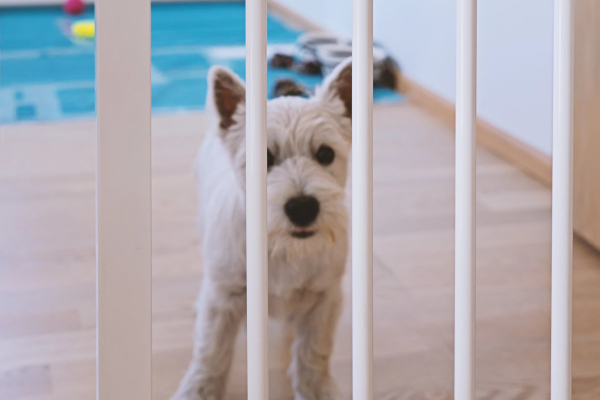
5. Keep your daily routine as normal as possible
Blind dogs find comfort in having a daily routine. As much as possible, try to feed your blind dog at about the same time every day. Take trips to the bathroom and walks at about the same time too. And visit the same area of the yard or walk the same path. As your dog gets more confident, you can walk in different places. But at the start, knowing what to expect is helpful for your dog.
6. Avoid picking up your dog and then setting him or her down in a different room
It may be tempting to carry your dog from room to room. However, when dogs are first learning to navigate their environment while blind, it can be disorienting for them to get picked up in one room and then set down somewhere else. If you do end up carrying your dog around for a bit, try to put him or her down where you picked him or her up, or somewhere that is easy to recognize like their bed, safe room, or near the food and water dishes.
7. Help your dog develop a mental map of the house
When your dog is ready and you have set up your house for success (see the next section for tips on this), walk your dog through the house on a short leash. Guide him or her along the path to the door to the outside. Take your dog over to the food and water dish, toy basket, bed, couch, etc. Doing this multiple times helps your dog create a mental map of the house so he or she can navigate more confidently.
Setting up your home and living space for a blind dog: 7 tips
You will probably need to make changes to your home to help your blind dog navigate successfully and stay safe. When thinking about how to care for your blind dog at home, consider implementing some of these seven ideas.
1. Don’t move your furniture
Your dog will use a mental map of the house to get from place to place safely. Thus, it is important that you keep the layout of your house as similar as possible. If you do get a new piece of furniture or need to adjust the furniture arrangement, guide your dog around the room on a short leash for a “mental map update.”
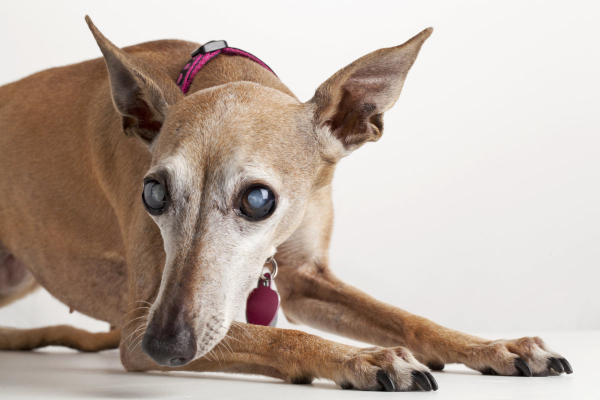
2. Keep your dog’s food and water bowls in the same location
Along the same lines, it is helpful to ensure your dog’s food and water bowls stay in the same location all the time. This makes it easy for your dog to find his or her food and water. Plus, dogs may use the location of their food and water bowls to orient themselves in the house. If your dog is acting lost or confused, bringing him back to where his food and water are may help him get his bearings again.
Some parents of blind dogs will change to a water fountain rather than a water bowl. This can be useful because the sound of the running water helps the dog find the bowl. And it also gives the dog clues about what room he or she is in.
3. Don’t leave things out on the floor
Sometimes it is easier said than done, but try your best not to leave toys, books, bags, etc. strewn all over the floor. They can pose a tripping hazard for your dog and make him or her less confident about moving around the house.
4. Dog proof your home
Since your dog can no longer see, it is important for you to look for and address any hazards that might be on his or her level. For example, the sharp corner of a table might poke your dog or scratch his or her eye. Or your dog could get tangled up in wires or cords. You may want to put foam bumpers on the edges of the furniture and fireplace hearth and ensure all cords are gathered up neatly.
5. Use different textures to help your dog find his or her way
Dogs can tell when they step from one texture to another. So using textured surfaces can be a helpful way to mark important areas in the home. For example, you could put a rubber mat under the food and water bowls. That way, the dog knows when he or she steps on the mat, the bowls should be close. Or you could place a specific rug at the door that goes to the outside.
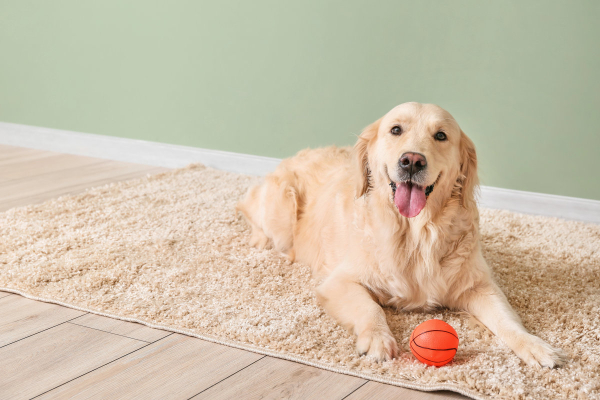
Some dog parents also use carpet runners to create walking paths for their dogs in the house. Or they may put a different textured rug at the top and bottom of the stairs. That way the dog knows he or she is approaching the stairs. Attaching a nonslip stair tread on each step can also help the dog feel the edge of the step.
6. Use scents or sounds as place markers inside your home
You can help your blind dog use his or her senses of hearing and smell to detect the location of furniture or doors or to help keep track of where he or she is. For example, some dog parents use one scent to mark things to avoid like the legs of furniture and corners. And they use another scent to mark the door to outside or the dog’s safe room.
Or they may play certain sounds in certain areas of the house. That way the dog knows that nature sounds correspond with the kitchen and hearing rainfall signals he or she is in the bedroom.
On a side note, bringing along a familiar blanket, toy, bed, or other item that smells like home can help a blind dog be more comfortable on trips.
7. Put bells on your shoes or on the collars of other pets
In addition to using sound as place makers in your home, you can help care for your blind dog by adding bells or sounds to the people and pets traversing your home! Bells can be a great auditory signal for your dog. Some dogs will learn to follow the jingle of bells on your other dog’s collar or on your shoe during a walk. (If your other dog’s tags jingle, this can work in place of bells.) Also a bell on the collar of other pets in the household can alert your blind dog when the pet comes into or leaves the room.
Safety note: Ensure that your pets are not going to try to eat the bells and/or be scared of them. Plus, use a breakaway collar on cats to avoid a strangulation risk and weigh the risks vs benefits of having dogs wear collars in the house.
11 things you can do in your new role as a parent of a blind dog
Last but certainly not least, it’s important to recognize that you’re adjusting to your new role as the parent of a blind dog too. There are many ways you can increase your emotional bond with your dog, offer support, and even provide products and training to benefit your blind dog. Here are 11 suggestions that you can add to your “caring for a blind dog toolbox” to help you confidently support your blind dog. You can do this, and we’re here to help you!
1. Be confident, calm, and positive as you care for your blind dog
Your dog loves you and is very in tune with your emotions. If you are anxious or stressed, he or she will be too. But if you approach the challenge of helping him or her adjust to being blind with a calm and positive attitude, it will rub off on your dog. Cheerfully and confidently interact with your dog and be ready with liberal praise and encouragement.
2. Talk to your blind dog
Your dog loves to hear your voice! Also, talking to your blind dog before you touch him or her can prevent your dog from getting startled, especially if your dog was sleeping. Plus, it is helpful to pick a word that you say to let your dog know when you are entering or leaving a room. The various commands outlined below can also help you use verbal cues to guide your dog.
3. Teach your blind dog navigation commands
It can be helpful to teach your dog some “navigation commands”. Decide as a family which words you want to use, and have everyone use the same commands. Some examples might be:
- Left/right—Turn left or right
- Step up/step down—Pick up your paw higher to go up a step or reach your paw down to step down (great for stairs and curbs)
- Slow—Walk more slowly and feel around carefully with your feet
- Wait—Pause until you get further instructions
- Load up—Jump into the back of a car/SUV (this one is a more advanced skill)
- Walkies/Walk on—Walk forward
- Watch—Be careful because you are getting close to something (furniture, door, etc.)
Sometimes people like to use clicker training when working on these commands. But you can also just use your voice to mark that your dog is doing something right.
4. Allow your dog to figure things out on his or her own but be ready to intervene as needed
Your dog needs to figure out how to live life now that he or she is blind. This means you need to be willing to let him or her struggle a little. It can be hard to do, but try to sit back and watch for a moment if your dog gets stuck in a corner or has trouble finding the door. If your dog seems calm and determined, see if he or she can figure it out. But if your dog is getting stressed or is about to get into an unsafe situation, gently provide some guidance.
5. Help your blind dog learn to go up and down the stairs
Often, stairs can pose a significant challenge for blind pets. You may need to use a treat and the “step up” and “step down” command to lure your dog up and down the stairs to build his or her confidence. Using tactile markers on the stairs (as we discussed earlier) can also help your dog figure out how and where to place the feet for the stairs.
6. Choose dog products that are helpful for blind dogs
There are a variety of aids that can help your dog gain confidence and navigate the house safely. Here are a few things I recommend:
Use a halo or bumper vest to protect your dog’s head
In some situations, you may want to try putting a halo or bumper vest on your blind dog. These assistance devices are made up of a curved rod that sticks out several inches in front of the nose and attaches to either side of a vest the dog wears. This way, the dog runs into the door, wall, etc. with the bumper rather than with his or her head. Not all dogs need or benefit from a halo or bumper vest, but it is good to know they exist.
Apply ToeGrips to help your dog walk more confidently
Some dogs who lose their sight are reluctant to move around their home. This may be true even when they have lived in that environment their entire life. As a result, they isolate themselves from their family and end up becoming fearful and anxious.
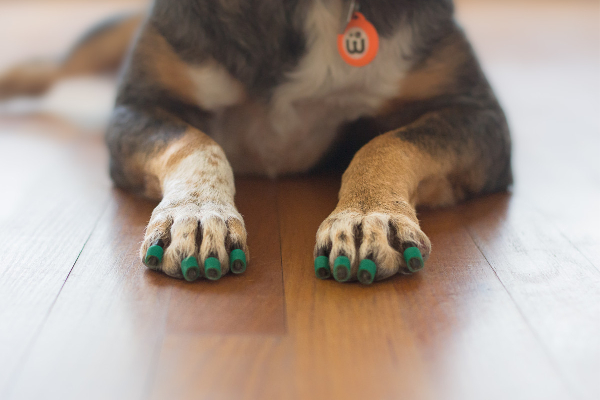
Cathy Symons, certified veterinary technician, certified canine rehabilitation practitioner, and author of Blind Devotion: Enhancing the Lives of Blind and Visually Impaired Dogs believes this is, in part, due to a loss of confidence.
Like sighted dogs, blind dogs use their toenails to get traction. Since blind dogs cannot see the floor beneath them, slipping on a slick surface can be especially frightening. That’s what happened to Ms. Symons’ dog, Booda, who became blind when he was seven years old. Booda would sit in one spot all day until a family member guided him around the house. Symons turned to Dr. Buzby’s ToeGrips® dog nail grips for help.
She put the non-slip grips on both of her blind dogs, Booda and Digger, and saw an immediate response. ToeGrips® dog nail grips gave the dogs’ the traction and tactile sensation they needed to get up and move around the house. And with increased mobility came increased confidence.
7. Use scented or noisy toys as enrichment play for your blind dog
If your dog loved playing with toys in the past, switching to ones that make noise or have a scent can make them easier for your blind dog to find. Plus, blind dogs may enjoy using food puzzle toys because they can smell and taste the food inside.
If you are looking for an activity for your blind dog to participate in, scent work or learning new tricks can both be fun and mentally stimulating.
8. Teach children how to approach a blind dog and supervise them carefully
A blind dog (or any dog really) may nip when startled. Teach your kids to always speak to your blind dog before touching (or approaching) him or her. This is especially important if your dog is sleeping. It is also a good idea to carefully supervise younger kids when they are in the same room as your blind dog. And keep your children and your blind dog separate when you can’t be watching.
9. Use a visual indicator to let others know your dog is blind and teach them how to greet your dog
It can be helpful to have a collar, bandana, or other marker on your dog that says something about being blind. That way people unfamiliar with your dog will know he or she can’t see. If someone new wants to pet your blind dog, instruct them to talk to your dog first and offer an outstretched hand to sniff. Then they can touch your dog if your dog seems relaxed.
10. Use caution when introducing your blind dog to new dogs
A blind dog can’t read other dogs’ body language. Thus, it is important to supervise interactions with new dogs carefully. Be ready to intervene if either dog starts looking stressed or upset.
It is also a good idea to keep an eye on the interactions between your newly blind dog and the other dogs in the household. Sometimes one dog becoming blind can shake up the social hierarchy a bit.
11. Figure out if your blind dog wants a buddy
As just mentioned, blind dogs can sometimes have trouble reading other dogs. However, they may also find comfort in the presence of another dog. And that dog may even end up being a sort of guide dog or confidence booster for the blind dog.
(Note: If you don’t already have other pets, it is generally not a good idea to add a new dog to the family right when your dog becomes blind. This is something to consider after your dog has adjusted a bit. And it takes a “buddy dog” with the right personality.)
BONUS! 5 outdoor safety tips for blind dogs
As your blind dog begins to venture into the yard or on walks, keep these five outdoor safety considerations in mind.
1. Keep your blind dog on a leash or in a fenced yard
It can be easy for a blind dog to get disoriented and wander into the road, get lost, or find himself or herself in a dangerous situation. Therefore, the safest thing is to either keep your dog on a leash at all times while outside or keep him or her in the fenced yard.
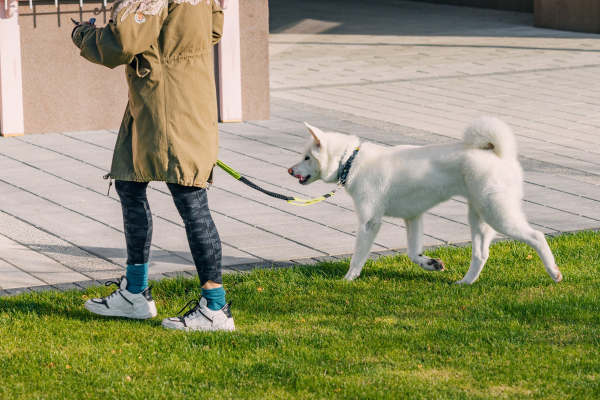
If you do want to let your dog off leash, consider putting a GPS collar on him or her. Additionally, it is important that your blind dog have a microchip with updated information and be wearing a collar with identification tags on it.
2. Mark important areas in the yard with a sound or change in texture
Putting gravel or mulch around the edges of the fenced yard can help your dog know where the boundaries are. Or you can use gravel or mulch to mark dangerous areas like raised garden beds or eye-level bushes.
Also, some parents of blind dogs will hang a wind chime near the door to the house. The sound can help a blind dog find the door again.
3. Put a fence around pools and avoid other bodies of water
Sadly, blind dogs can potentially drown if they fall into a pool, pond, or lake and can’t get out again. Thus, putting a cover on your pool or fencing it off, and keeping your dog away from other bodies of water when you are not there to supervise, is the safest approach
4. Keep your dog on a short leash while walking
It can be helpful to keep your dog close to you on a short leash while on a walk. This way you can more easily guide your dog around any obstacles. Plus, your dog can walk more confidently knowing that as long as he or she is close to you, you will be looking out for him or her.
Some blind dogs like walking on leash with a collar and others prefer the increased contact that a harness provides. You can see what works best for your dog.
5. Be alert while on walks with your dog
It can be easy to space out or enjoy the scenery when on a walk. However, when walking a blind dog, it is important that you are constantly tuned into what is going on around you. Your dog is relying on you to guide him or her safely.
Blindness doesn’t have to steal your dog’s joy
Over my 25+ years in practice, I have met so many blind dogs who are happy, friendly, and still living their best lives.
There is definitely an adjustment period for your dog as he or she learns to navigate the world without sight, and for you as you figure out how best to care for a blind dog. But once you get through those challenging first weeks (or sometimes months), things get easier. Helping your blind dog becomes second nature. And you will begin to see that your blind dog really can continue to live a full and joyous life.
If you just learned your dog is blind, don’t despair. Instead, work with your vet to figure out how to manage the medical aspects of your dog’s blindness. Then sit down and make a plan for how you are going to help your blind dog regain his or her confidence and stay safe. And of course, take some time to just be with your dog too and enjoy the bond you share.
Do you have an additional ways to care for a blind dog?
Please comment below.
photo credit: 009012 – Perro via photopin (license)


Our dog Molly has SARDS and although she is slowly adjusting to being blind, she is constantly barking. The only thing that seems to stop her is feeding her and now we have to moderate that because she is getting so fat. She seems to be afraid to be left alone after a few months of the diagnosis. We give her small healthy treats in between meals and walk her a lot. Any ideas to help her settle more?
Hi Jilda,
I am sorry Molly is having trouble adjusting to life without her sight. Anxiety can be a normal consequence of a sudden life change. It sounds like you are doing a great job and Molly is very lucky to have you taking such good care of her. If she responds well to food and treats, you could turn this into a mental simulation game that could offer distraction and a way for her to work through some of her stress. I highly recommend you look into puzzle feeders, snuffle mats, or even toys that slowly release kibble as they are pushed around. It would also be wise to discuss this with your vet as Molly might be a good candidate for anti-anxiety medication just to help take the edge off. Some people have used medications such as trazodone or even supplements like CBD products and calming collars, diffusers, or shirts. I am hopeful you will find a way to give your pup relief and peace. Wishing her many happy days ahead and keep up the great work!
my dog Charley was 10+ yrs old, 1 eye gone and losing sight in the other. he’s learned to use pee pads, plays with squeak toys, I clap my hand as I walk , and always use place names so he knows where or what is taking place. treats are his favorite words and friends know in advance he can’t see, also to not touch without speaking first..
Hi Judy,
Charley sounds like an amazing pup! Thank you for sharing his story with us. The use of places names is such a great idea. Best wishes to you both. ♥
Please, our 14 year old fully sighted, until last week( stroke) needs more help and advice. I don’t know if we’re sulking more or him? Anyone might have more insight or ideas please? Sad for Royce( his mommy) Patty
Hello Patty, I’m so sorry to hear about your 14-year-old dog’s recent vision loss. My first thought is that strokes are not nearly as common in veterinary medicine as people think. Perhaps setting up a recheck with your vet or getting a second opinion on the diagnosis (ideally by a board certified veterinary ophthalmologist) would be the best place to start to confirm the diagnosis. From there, you can work with your vet on a treatment plan to include activities that will be fun and engaging for Royce. I hope this helps!